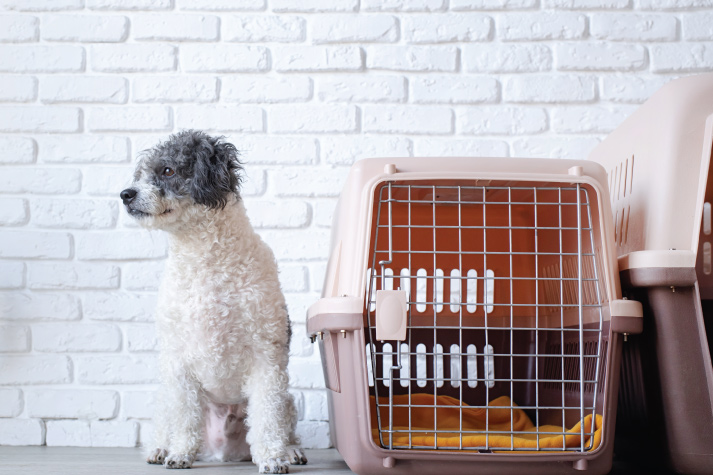Choosing the Right Pet Crate: A Guide
It is a commonly held belief that a pet crate is rarely used, only seeing the light of day when swapping residences or states. However, this is an underutilization of a crate, as it’s good for pet travel and so much more. For instance, if you have a pet who's shy, anxious, or high in energy, a pet crate provides a safe space for them where they can relax and not be overwhelmed with anxiety or excitement every time they have company at home.
A pet crate is a great way to slowly socialize your pet or keep them separate from other pets in the house. It helps give your pet a safe space where they can retreat if overwhelmed. It also works when you need to visit the vet for routine vaccinations or a quick shopping run. On top of that, a pet crate is a must-have accessory if you’re someone who travels with their pet in their car; an unrestrained pet in a car is one of the top causes of distracted driving, and your pet flying into the windscreen when you inevitably brake hard is not ideal.
Given how pet crates can be useful in a variety of ways, it is important to choose the correct one. Here’s a handy guide which will help you select an appropriate pet crate for your pet depending on your usage.
Things to Consider Before Buying a Pet Crate
No two pets are exactly alike, nor are their needs. Therefore, you need to make sure you consider a few factors before splashing cash on a crate.
- Usage: Each pet crate or carrier serves a different purpose. If you’re looking for a crate that covers every base and will be good for both home use and travel, you can opt for a hard-sided pet travel crate. Such a crate is strong and sturdy, meaning you won’t have to worry about the crate squishing like a soft bag or carrier would. To top it off, they’re essential if you embark on frequent pet travel by road, or if you’re moving to a new country using a plane.
- Sizing: The crate you choose must be sized correctly, not too big or too small. Since the crate is your pet’s own little space, it should have enough room for them to stand up, turn around, and lie down. Choosing a crate that’s larger than normal will come with its issues, and you don’t want to be paying extra for pet travel when the larger crate costs more to ship due to its volumetric weight. The best size is the right size, so measure your pet and make sure you have the correct crate before purchasing it.
- Pet’s needs: As mentioned previously, each pet is different. Some pets are shy and docile, others are rambunctious or full of mischief. Depending on the personality of your pet, you may end up with a different type of crate than what you initially imagined in your mind. For instance, a pet who is an escape artist will be better off in a hard-sided pet crate since it provides fewer opportunities for them to escape their confinement. Similarly, if you have a shy or anxious pet, they will need a carrier with vented fold-down sides to help them hide away. A very sociable or friendly pet could fit in a sling bag or pet backpack, although this method requires your pet to be of a relatively small size and a tolerant temperament.
- Construction: The construction of your pet’s crate matters. Regardless of the pet you have, you'll need to make sure your pet's crate is a welcoming space and will ensure their comfort. For instance, older, overweight, or brachycephalic pets will require a crate which guarantees airflow throughout the journey, no matter how lengthy it is. For a carrier, choose one which guarantees ventilation and is constructed from a breathable material. For a crate, you can choose an IATA-approved pet crate; these crates are made of fibreglass and are designed to comply with the strict rules of pet travel, meaning your pet will be just fine inside it whether at home or when travelling.
Types of crates
- Carrier Backpack: As the name implies, a carrier backpack is a backpack for your small pet. They’re great for a quick run around town and are best suited for smaller pets who are tolerant of other people and pets or unreactive at the very least.
- Soft Carrier Bag: A dog carrier bag is akin to a duffle bag with perforations for ventilation. With a soft, zip-up top, your pet will be more than comfortable in this bag thanks to its mesh windows and removable liners.
- IATA-accredited Pet Travel Crate: An IATA-accredited pet travel crate is specifically designed to keep your pet healthy and comfortable. Since they're used for pet transport over long distances, such crates are designed according to the rigorous specifications of the International Air Transportation Association, meaning they’re strong, sturdy, well-ventilated, and will keep your pet safe.
To conclude, there is a plethora of carrier options available to you as a pet parent. Each will have certain perks and a few cons, so make sure to do your due diligence and select the correct crate for your pet. As long as you remember that your pet’s comfort is the priority and choose the correct size of crate/carrier, you should be good to go. Happy shopping!




AUTHOR’S BIO
Shivangi Lawania
Storytelling is my way of bringing ideas to life. I enjoy shaping words that spark curiosity and connection, while keeping a strong focus on branding and communication. For me, great content blends creativity with clarity to leave a lasting impression.